Table of Contents
What is an Ophthalmic Prism:
- A Prism is a refracting medium having two plane surfaces inclined at a finite angle.
- In ophthalmic lens, prisms are usually have curved, rather than flat surfaces.

- Prisms are available as:
- Unmounted loose prisms,
- Mounted prisms in trial lens set
- Prism bars (horizontal and vertical)
- Prism may be used in conjunction with spherical, cylindrical, or sphero-cylindrical power.
Parts of Ophthalmic Prism:
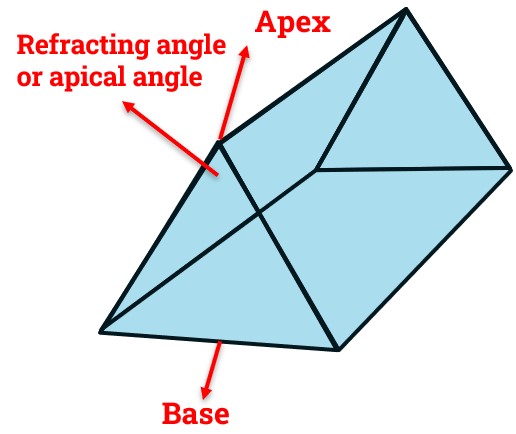
Refracting angle or apical angle:
- Refracting angle or apical angle of a prism is the angle between two surfaces and is denoted by the Greek letter β (beta)
- The greater the angle formed by two surfaces at the apex, the stronger the prismatic effect.
Apex:
- The apex of a prism refers to the point at which the two sloping surfaces of the prism meet each other.
- In other words, it’s the highest point of the triangular sides of the prism.
Base:
- Base of prism refers to the surface opposite to the apical angle.
Edge:
- The straight line at the apex, in which the two surfaces of the prism meet, is known as the edge of the prism.
Refraction through Ophthalmic Prism:
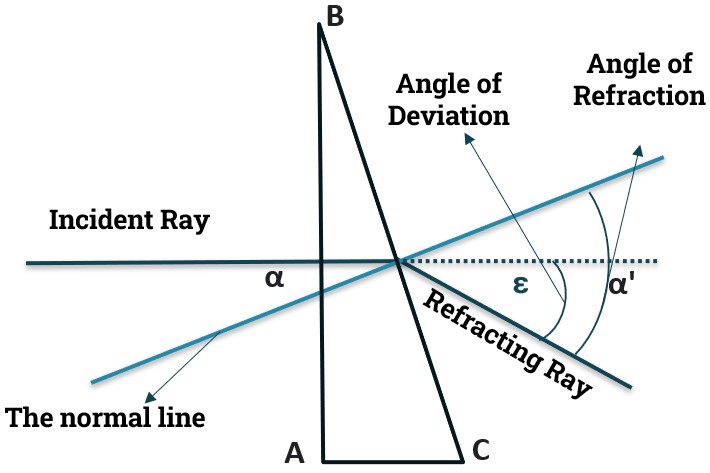
- Light ray passing through a prism, deviated towards the base of prism.
- Due to deviation of rays towards the base, image shift towards the Apex.
- So, Prism shift light rays towards the Base and shift Image towards the Apex.
- Characteristics of Image formed by a prism are:
- Erect,
- virtual
- Displaced towards the apex
Unit of Prism:

- The power of a prism to bend light is measured in prism diopters (PD).
- One prism dioptre produces displacement of an object by 1 cm when kept at a distance of 1 meter.
Angle of Deviation:
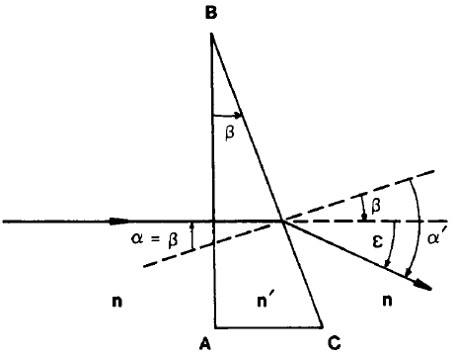
- Angle of deviation refers to the net change in direction of the light ray passing through the prism.
- Angle of deviation is denoted by the Greek letter ε (epsilon).
- It depends on three factors
- Refractive index of the prism material.
- Refracting angle of prism and
- Angle of incidence of the ray.
- Angle of Deviation can be identify using the formula:
Here, ε = Angle of Deviation, β = Angle of Refraction, n = Refractive Index of Prism
- Usually, Prism has refractive index of 1.5. So the formula becomes:
- ε = β (1.5 – 1)
- ε = β (0.5) or β/2
So, Deviation of prism is equal to half of the refractive angle of the prism.
- As a rule of thumb, for crown glass having an index of refraction of 1.523, a prism having a refracting angle of 1 degree produces approximately 1 prism diopter of deviation.
Degree vs Prism Diopter:
- 1° = 1.75 Prism Dioptres
- 1 Prism Dioptre = 0.57 °
In Practice we generally consider 1° = 2 prism dioptre for easy calculation of deviation.
Ophthalmic Prism vs Ophthalmic lens:
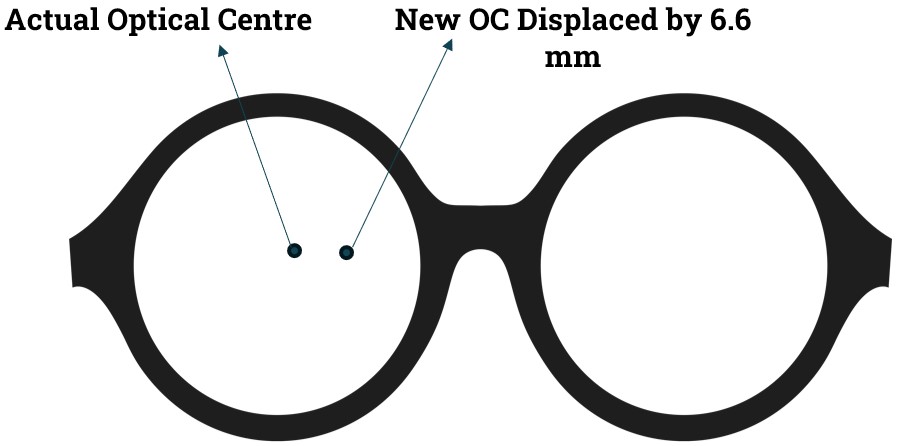
- Prism is incorporated in ophthalmic lens through grind the prism into the lens by surfacing process.
- However, even a spherical or cylindrical lens will induce prismatic power whenever the visual axis passes through any point in the lens other than its optical center.
- Thus, a second method of providing prismatic power in an ophthalmic lens is to “decenter” the lens.
- The prismatic effect induced due to rays passing through decentered point of a lens can be identify using Prentice’s Rule.
P = h x D
Here,
- P = is prism dioptres of displacement.
- D = is the dioptric power of the lens, and
- h = is amount displacement of OC in centimetres.
For example, if the lens power is +2.00 D and the OC is displaced by 6 mm, what will be the induced prism?
Here,
- D =2.0D
- h = 6 mm or 0.6 cm
So,
- D = 0.6 × 2.00
- D = 1.2 Prism Dioptres (PD)
Suppose a prescription has 2PD BO prism in OD with refractive power in OD -3.0. Where will you mark the new optical center?
Here,
- P = 2PD
- D = 3.0D
- h = Displaced or New Optical Centre.
We know that,
- P = h X D
- Or h = P/D
- Or h = 2/3
- Or h = 0.66cm or 6.6 mm
So, the new optical center will be 6.6 mm displaced from the actual Optical Centre.
Effects of Ophthalmic Prism in Eye Movements:
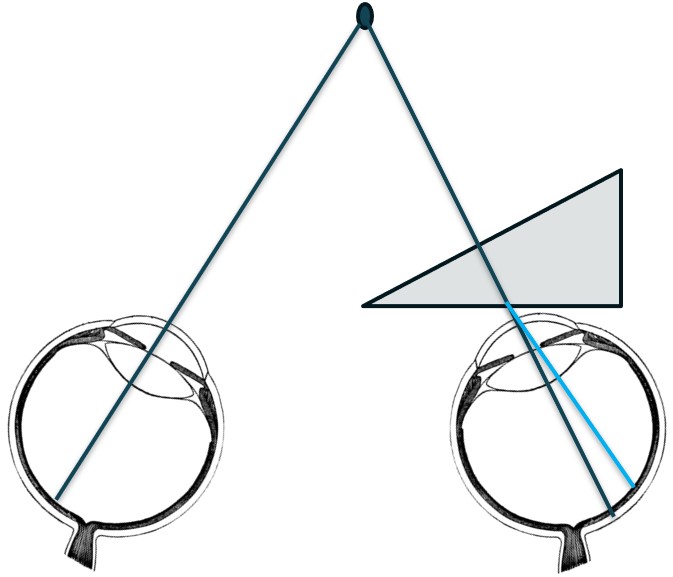
- When a prism is placed in front of eye it will move towards the apex of the prism.
Why does eye move towards the Apex of the Prism?
- Our eyes are positioned in such a way so that rays from an object can fall in the fovea.
- Now, when a prism a placed in front of the eye, it will bend the rays towards the base.
- Due to bending rays towards the base of prism, ray that was focused on the fovea now will fall in an extra foveal area.
- When ray shift from fovea to extra foveal area, eye will also move in such a pattern (towards apex of prism) so that the ray can fall in the fovea.
- If eye doesn’t move, then due to the ray focusing on an extra foveal area will create diplopia.
- That’s why eyes moves towards the apex of the prism so that rays can be focused on the fovea.
Effects of Ophthalmic Prism
- The effects of prisms on movements of the eyes may be considered in terms of either,
- Monocular effects or
- Binocular effects,
- Binocular effects may be considered in terms of:
- Horizontal prismatic effects.
- Vertical prismatic effects.
Monocular Prismatic Effect:
- If one looks at a distant object with one eye occluded while a prism is introduced before the eye, the image of the object will be displaced toward the apex of the prism.
- If the person wishes to look at the image of the object, the eye must move through an angle equal to the angle of deviation of the prism.
- Base-in prism would cause the eye to move outward (abduction), and base-out prism would cause the eye to move inward (adduction).
Binocular Prismatic Effects:
- If, with both eyes open, one looks at a distant object while a base-in prism is placed before the right eye and a base-out prism of equal amount is placed before the left eye, in order to look at the object both eyes will move to the right by an equal amount.
- The movements of the eyes in which both eyes move in the same direction and of an equal amount are called conjugate movements, or version movements.
- If a small amount of base-out prism is placed before each eye, in order to see a single image both eyes will move inward by the same amount.
- Eye movements in which the eyes move toward one another (convergence) or away from one another (divergence) are called disjunctive movements, or vergence movements.
Horizontal Prismatic Effects:
- When prisms are placed before each eye with their both base in or both base out, the resultant amount of prismatic effect can be found by adding the powers of the prisms (base in added to base in, or base out added to base out).
Example:
- OD 3 prism dioptres, base out
- OS 3 prism dioptres, base out.
Effect = Rt eye Prism + Lt eye Prism
- Effect = 3PD + 3PD or 6PD
- The resultant prismatic effect is 6 prism dioptres base out.
Horizontal Prismatic Effects:
- If the bases are in opposite directions but of different powers, the power of the weaker prism is subtracted from the stronger prism to get the resultant prismatic effect.
Example:
- OD 4 prism diopters, base in
- OS 2 prism diopters, base out.
Effect = Stronger Prism – Weaker Prism
- Effect = 4 PD – 2 PD or 2 PD
- The resultant prismatic effect is 2 prism dioptres base in.
Vertical Prismatic Effects:
- When vertical prisms are placed before each eye with their bases in the same direction for each eye but with different powers, the resultant vertical prismatic effect is found by subtracting the power of the weaker prism from the stronger prism.
- The direction of base of the resultant vertical prismatic effect will be same as stronger prism.
Example:
- OD 3 PD, base up.
- OS 1 PD, base up.
Effect = Stronger Prism – Weaker Prism
- Effect = 3 PD – 1 PD or 2 PD
- The resultant prismatic effect is 2 prism dioptres base up in right Eye.
Vertical Prismatic Effects:
- If the bases are in opposite directions, the resultant vertical prismatic effect is found by numerically adding the powers of the two prisms.
- Since a base-up effect for one eye is the same as a base-down effect for the other eye, the total prismatic effect may be expressed with respect to either eye (base-up for one eye or base-down for the other eye).
Example
- OD 2 PD, base down.
- OS 2 PD, base up.
Effect = Rt eye Prism + Lt eye Prism
- Effect = 2 PD + 2 PD or 4 PD
- The resultant prismatic effect is 4 PD base down in Rt eye or 4PD Base Up in Lt eye.
Check Our Courses: Ophthalmic Instrumentation, Clinical Refraction, Contact Lens, Binocular Vision, Dispensing Optics, MCQs in Optometry
Download our App “Optometry Notes & MCQs” from Google Play Store.

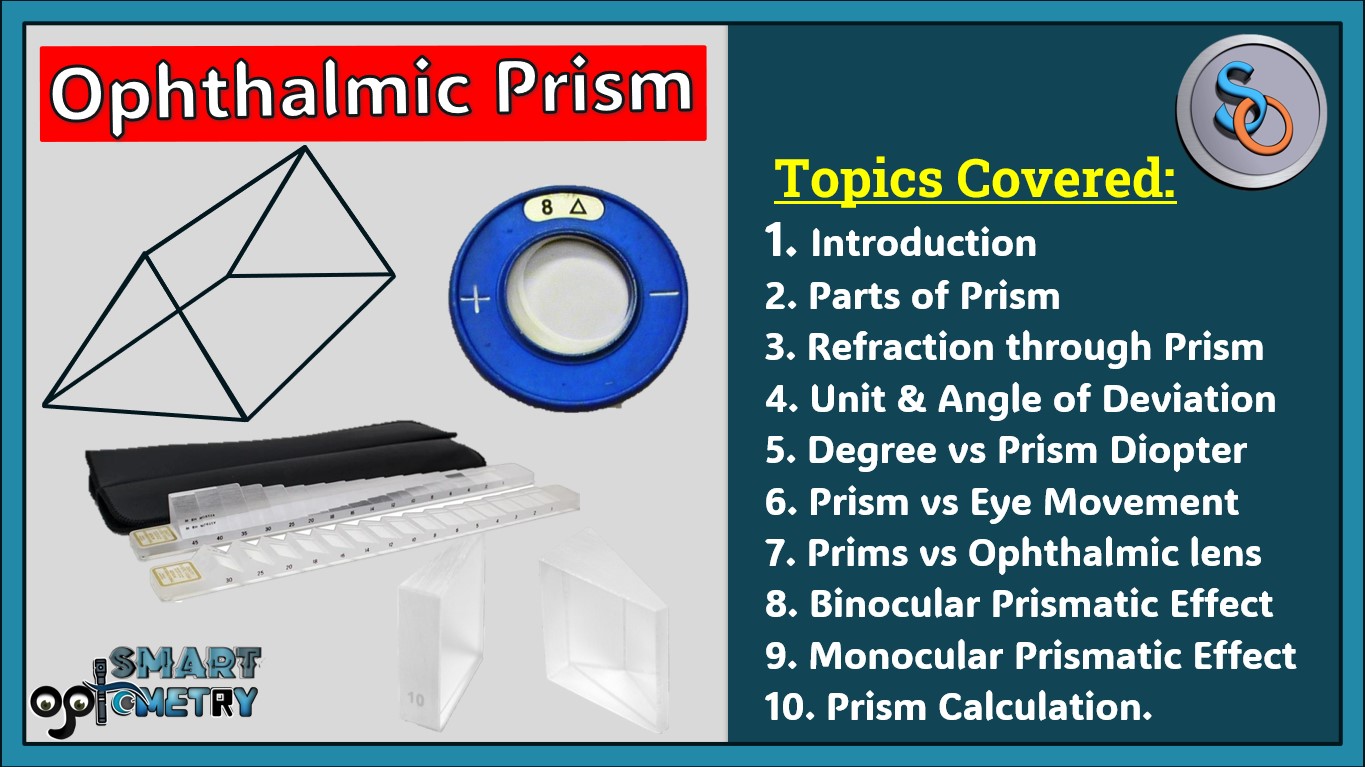
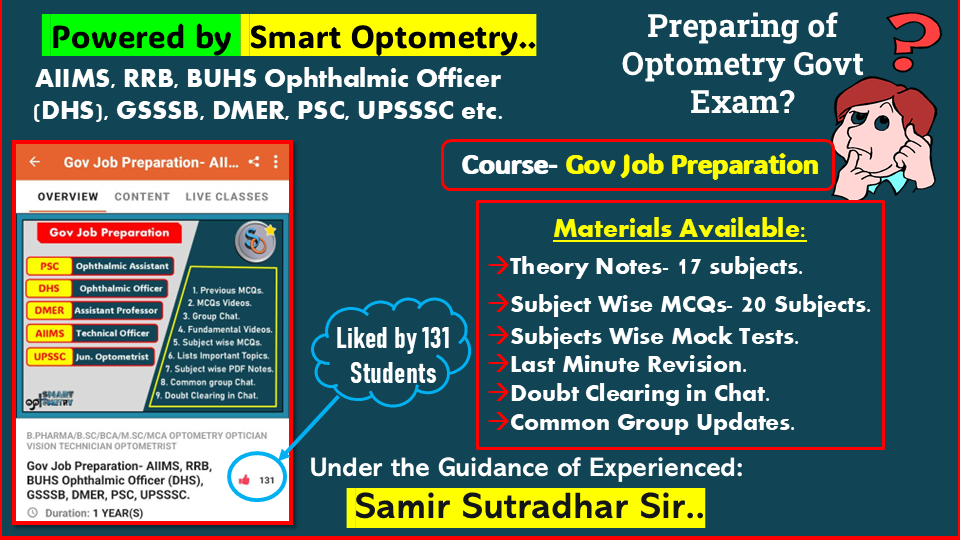


4 Comments
The actual image and deviated image will be at 1 meter from the Prism but the separation between these images will be 1 centimeter.
In your figure of “unit of Ophthalmic Prism”, the object is defined to be 1m from the prism. But at what distance is the image or the deviation of 1cm supposed to be measured?
Please type in English….
quidem eaque perferendis laudantium in velit aut sed magnam itaque. nobis vel soluta quasi quia voluptatem deleniti non eveniet qui iste maxime et dicta.